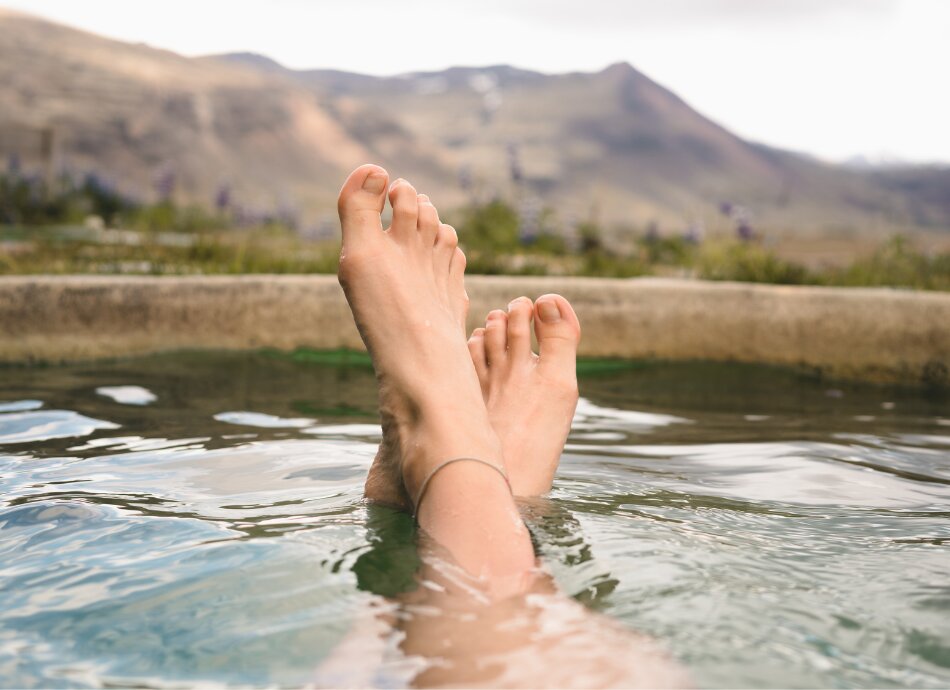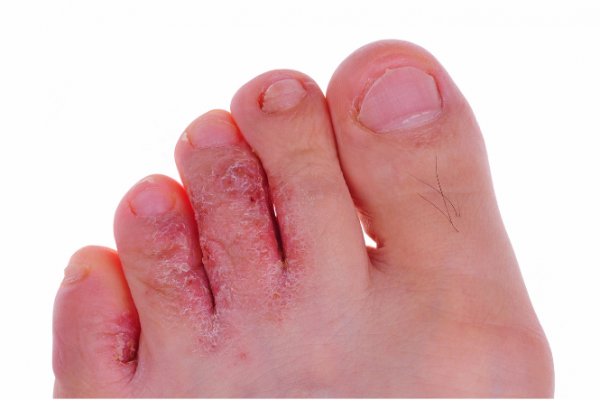Athlete’s foot
Key points about athlete’s foot
- Athlete’s foot (also known as tinea pedis) is a common fungal skin infection. You can often treat it with cream from your pharmacy.
- Symptoms include include raw, cracked or scaly skin, redness and itching. Usually the symptoms involve the skin between your toes.
- Treatment includes keeping your feet clean and dry and using antifungal cream or tablets.
- You can help prevent athlete’s foot by drying your feet well after washing and changing your socks every day and not going barefoot in public changing rooms.

Athlete’s foot is caused by tinea (a ringworm fungus). It can be easily caught through touching an area of fungal skin infection on another person or animal. You can also catch it from an object or surface that has been touched by the infected skin of a person or animal. Common places you can catch athlete’s foot from include bathroom or shower floors, bathmats, towels and swimming pool or gym changing rooms.
You are more likely to get the infection if you:
- have wet or sweaty feet
- have damaged skin on your feet
- walk barefoot in public places
- have diabetes or other conditions that weaken your immune system, eg, you are on chemotherapy
- are on medicines such as steroids or immunosuppressive medicines.
Symptoms of athlete's foot can include:
- redness or itching, often between your toes
- itchy white patches between your toes
- burning or stinging
- a rash that may form blisters or pustules
- raw, inflamed, cracked or scaly skin
- if severe, weeping or oozing areas of skin.

Image credit: Canva
Athlete's foot is not usually serious. The fungal infection can sometimes spread to other body parts such as your groin skin or toenails, but it does not usually spread deeper than your skin or nail. Treatment usually works well.
Occasionally athlete’s foot can lead to other skin infections, such as cellulitis, because bacteria can get in through broken skin. This means it's good to get athlete’s foot treated properly.
Usually athlete’s foot can be diagnosed by your doctor examining your foot and asking you questions. Your doctor may check other parts of your body to find out whether other areas also have a fungal infection, such as your groin, toenails or leg. If the cause for your symptoms is not clear, a small scraping of your skin may need to be sent to the laboratory for analysis. You may also be referred to a dermatologist (a skin specialist doctor).
Apps reviewed by Healthify
You may find it useful to look at the DermDiag app.
You can often treat athlete's foot at home with cream you can buy from a pharmacy. Talk to your pharmacist to find out if that is safe for you.
Treatment includes:
- self-care such as keeping your feet clean and dry
- medicines such as antifungal cream or tablets.
|
See your GP if: |
|
Self-care
If you have athlete’s foot, it is important to keep your feet clean and dry.
- Shower or bathe daily and dry thoroughly between your toes.
- Wear socks made from fibres that draw moisture away from your skin, such as wool or cotton.
- Change your socks every day.
- Don't share towels, shoes or socks with other people.
- Wash socks, towels and bathmats in very hot water (over 60ºC) and dry them well.
- Don't walk around barefoot in public places such as changing rooms.
- Don't wear shoes that make your feet hot and sweaty.
- Take your shoes off when you are at home.
- Don't scratch the affected area as this can spread the fungus.
Medicines
The usual treatment for athlete’s foot is an antifungal medicine. These can come as a cream, ointment or tablet. They can be bought from your local pharmacy or be prescribed by your doctor. Follow the instructions on the pack carefully. Some products need to be used regularly until 1 or 2 weeks after the infection has cleared, to prevent the infection from coming back.
Antifungal medicines used to treat athlete’s foot include:
- miconazole cream
- clotrimazole cream
- itraconazole tablets
- terbinafine cream or tablets
- fluconazole tablets.
Once your infection has gone, try to prevent it from coming back by:
- keeping your feet clean and dry
- changing your socks every day
- taking off your shoes and socks when you are at home
- wearing open-toed shoes if possible
- alternating the shoes you wear each day so they can dry out (air them in the sun if possible)
- drying your skin carefully after you shower or swim
- wearing jandals or plastic sandals in public swimming or changing areas
- not sharing towels with others.
Despite the name, athlete's foot can happen to anyone. It is a common fungal infection that most people get from walking barefoot in moist public places, like a swimming pool deck or locker room. Athlete's foot can result in flaky skin, cracking and itchiness on the soles of the foot and between the toes. If your athlete's foot does not improve, see your local doctor or nurse.
Video: How to prevent athlete's foot
This video may take a few moments to load.
(American Academy of Dermatology, US, 2014)
The following links provide further information on athlete’s foot. Be aware that websites from other countries may contain information that differs from New Zealand recommendations.
Ringworm and tinea infection – a patient’s guide(external link)(external link) Family Doctor, NZ
Athlete’s foot(external link)(external link) Patient Info, UK
Athlete’s foot(external link)(external link) NHS, UK
Apps
References
Credits: Healthify editorial team. Healthify is brought to you by Health Navigator Charitable Trust.
Reviewed by: Dr Alice Miller, FRNZCGP, Wellington
Last reviewed:
Page last updated:





